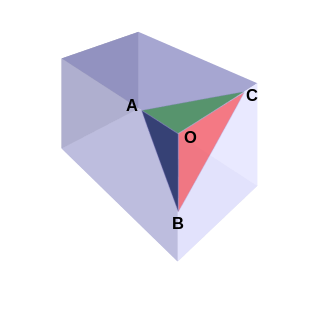De Gua's theorem

De Gua's theorem is a three-dimensional analog of the Pythagorean theorem and named for Jean Paul de Gua de Malves.
If a tetrahedron has a right-angle corner (like the corner of a cube), then the square of the area of the face opposite the right-angle corner is the sum of the squares of the areas of the other three faces.
Generalizations
The Pythagorean theorem and de Gua's theorem are special cases (n = 2, 3) of a general theorem about n-simplices with a right-angle corner. This, in turn, is a special case of a yet more general theorem by Donald R. Conant and William A. Beyer,[1] which can be stated as follows.
Let U be a measurable subset of a k-dimensional affine subspace of (so ). For any subset with exactly k elements, let be the orthogonal projection of U onto the linear span of , where and is the standard basis for . Then
where is the k-dimensional volume of U and the sum is over all subsets with exactly k elements.
De Gua's theorem and its generalisation (above) to n-simplices with right-angle corners correspond to the special case where k = n−1 and U is an (n−1)-simplex in with vertices on the co-ordinate axes. For example, suppose n = 3, k = 2 and U is the triangle in with vertices A, B and C lying on the -, - and -axes, respectively. The subsets of with exactly 2 elements are , and . By definition, is the orthogonal projection of onto the -plane, so is the triangle with vertices O, B and C, where O is the origin of . Similarly, and , so the Conant–Beyer theorem says
which is de Gua's theorem.
The Conant–Beyer theorem is essentially the inner-product-space version of the Pythagorean theorem applied to the kth exterior power of n-dimensional Euclidean space,[2] so it can be seen as both a generalization and a special case of the Pythagorean theorem.
History
Jean Paul de Gua de Malves (1713–85) published the theorem in 1783, but around the same time a slightly more general version was published by another French mathematician, Charles de Tinseau d'Amondans (1746–1818), as well. However the theorem had also been known much earlier to Johann Faulhaber (1580–1635) and René Descartes (1596–1650).[3][4]
Notes
- ↑ Donald R Conant & William A Beyer (Mar 1974). "Generalized Pythagorean Theorem". The American Mathematical Monthly. Mathematical Association of America. 81 (3): 262–265. doi:10.2307/2319528. JSTOR 2319528.
- ↑ Lemma 8 and Theorem 9 of James G. Dowty (2014). Volumes of logistic regression models with applications to model selection. arXiv:1408.0881v3 [math.ST]
- ↑ Weisstein, Eric W. "de Gua's theorem". MathWorld.
- ↑ Howard Whitley Eves: Great Moments in Mathematics (before 1650). Mathematical Association of America, 1983, ISBN 9780883853108, S. 37 (excerpt, p. 37, at Google Books)
References
- Sergio A. Alvarez: Note on an n-dimensional Pythagorean theorem, Carnegie Mellon University.
- De Gua's Theorem, Pythagorean theorem in 3-D — Graphical illustration and related properties of the tetrahedron.
Further reading
- Kheyfits, Alexander (2004). "The Theorem of Cosines for Pyramids". The College Mathematics Journal. Mathematical Association of America. 35 (5): 385–388. JSTOR 4146849. Proof of de Gua's theorem and of generalizations to arbitrary tetrahedra and to pyramids.